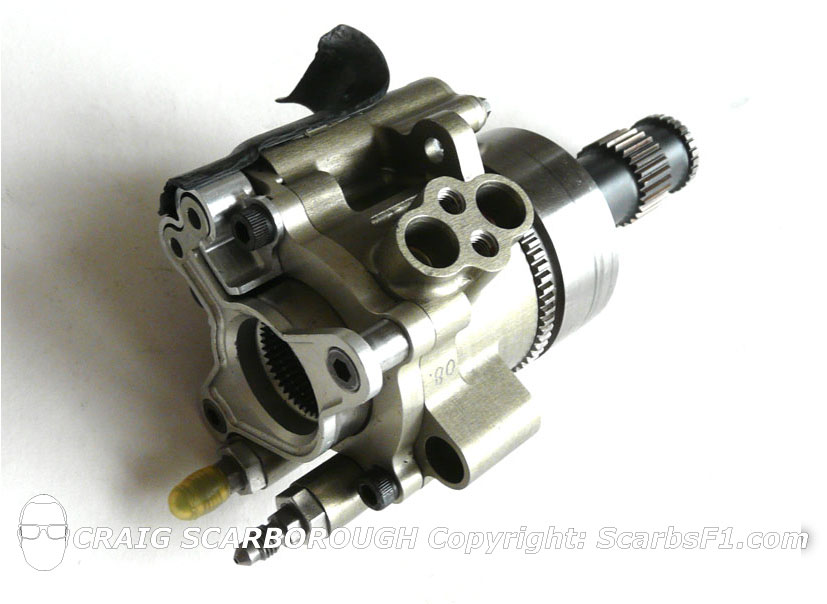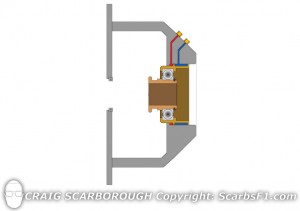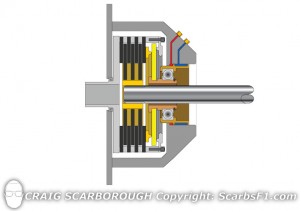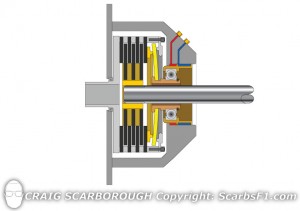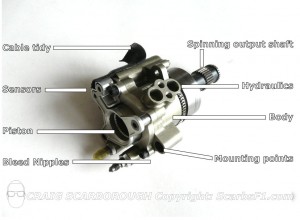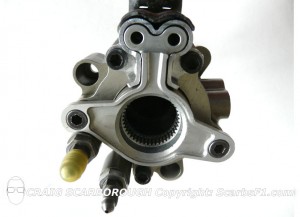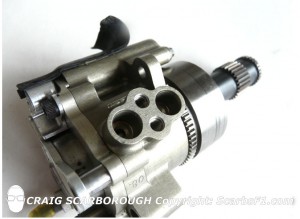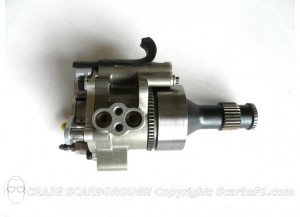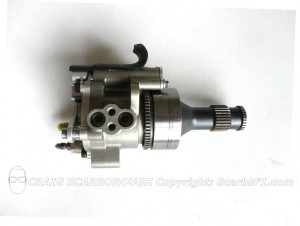Every time an F1 car comes to a halt or pulls away, the clutch needs to be operated. In an F1 car this is not cable operated, but controlled by the cars high pressure hydraulic control system. Converting the drivers demand for clutch movement into motion at the clutch spring is the Clutch slave cylinder. With an outwardly simply task to accomplish, the unit hides a lot of complexity.
Purpose
In its default engaged position the clutch is clamped shut by the diaphragm spring. To be disengaged the clutch spring needs to be pulled outwards to release the pressure on the clutch plates. This movement is provided by the clutch slave cylinder, a small hydraulic component mounted between the engine and the clutch.
When hydraulic pressure is applied to the cylinder the piston moves outwards and the piston pulls on the spring to release the clutch. Each teams slave cylinder and mounting is different, with the slave cylinder being either a separate part or integrated into its mounting around the clutch, these mountings typically being a tripod frame or semi enclosed cylinder mounting.
Above: Clamped the slave cylinder is closed
Below: Released the slave cylinder pulls the clutch spring to disengage the clutch
Anatomy
The slave cylinder is a relatively simple part, but the vital role it plays in getting the car to make a lightning fast and consistent race start, means there is added complexity to the underlying design.
Starting with the body, the part is CNC machined from solid metal stock (steel or titanium), as is typical with F1 parts all the hydraulic connections, mounting and critical surfaces are made as one part. Effectively the body forms a jacket around the piston so the inner bore must be machined accurately to seal the pressurised hydraulic fluid inside.
Within the body is a sliding piston again turned from solid and hollow both for weight saving and to allow the shaft from the engine to pass through it. The outer surface fits inside the body and the gap is sealed to maintain pressure. This seal forms a cylinder between the body and piston, the piston has flange that splits this cylinder to allow hydraulic pressure to move the piston both in and out of the body.
Both the body and piston remain static in respect to the rotating parts that they connect to. To prevent the piston also spinning, a yoke and slider arrangement keep it in line with the body. If the piston were to spin at the 18k rpm crankshaft speed of the engine, it would soon wreck the seals.
As the slave cylinder needs to connect to the engine and clutch at crankshaft speed, there is a tail to the piston that is free to spin on bearings. As this is beyond the sliding surfaces it is able to translate the sliding movement and still rotate.
Hydraulic pressure is needed for two functions, one to open and one to close the piston. The hydraulic lines screw in to the body at the side, each one on either side of the flange on the piston. A pair of bleed nipples allows the system to be bled to remove trapped air form each side of the piston flange.
To detect the clutch position and send the data back to the SECU, there is a pair of sensors on top of the assembly. A pair of sensors are used, as in case one fails there is back up. These fit into drillings in the body and detect the movement of the yoke attached to the pistons.
Lastly a carbon fibre cable guide is bonded to the body; this is probably to retain the hydraulic lines from the side of the body. Such is the detail these tiny carbon fibre brackets even feature elongated holes to allow a cable tie to pass through to secure the hydraulic lines.
Operation
When the driver moves the clutch paddles, the rotary sensor on the paddle detects the movement and sends signals through the steering wheel interface over a CAN network to the SECU, this instructs the hydraulic MOOG valve to open to allow pressure to feed the slave cylinder.
One MOOG valve will send fluid to either inlet to open or close the piston. This valve is typically mounted along with the other gearbox functions into a single hydraulic valve block, mounted alongside the gearbox. This will be fed with hydraulic pressure by the pump on the engine.
Fluid will pressurise one side of the cylinder formed by the body and piston, then act against the flange to move the piston a proportional amount to the steering paddle movement. Clutch travel is just 4mm, so the movement needs to be very accurate and tightly controlled. As race starts need to be consistent any friction in the actuator will skew the accuracy of the clutch movement and hence the speed of the start.
Although the slave cylinder is mounted between a very hot engine and gearbox and next to a very hot clutch no specific cooling system is used. Only the general airflow that is fed into the clutch area by ducts usually split off the from the airbox or oil cooler duct work.
